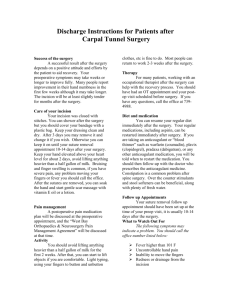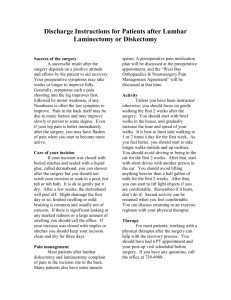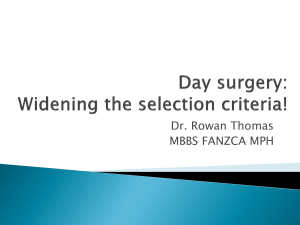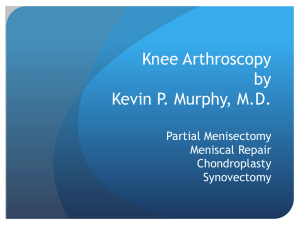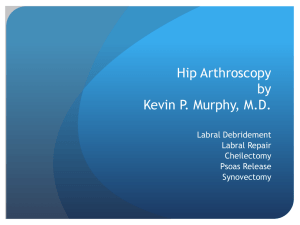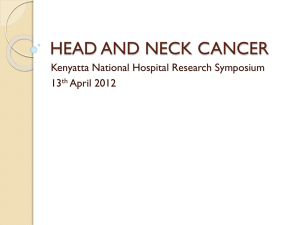CUBITAL TUNNEL RELEASE
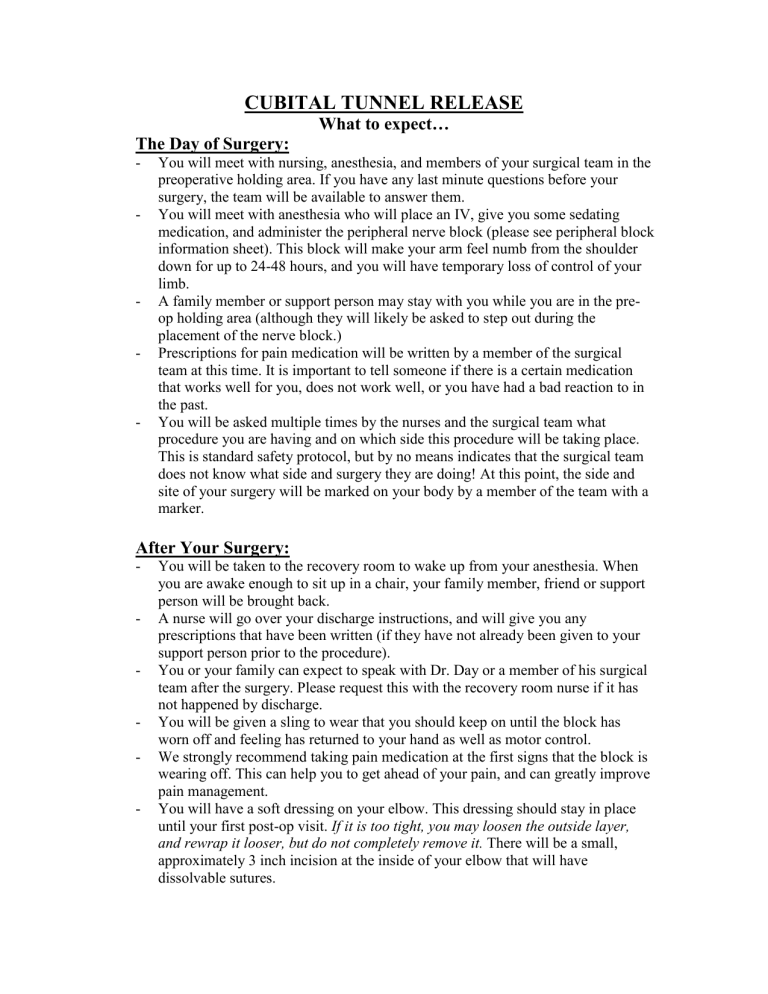
CUBITAL TUNNEL RELEASE
What to expect…
The Day of Surgery:
You will meet with nursing, anesthesia, and members of your surgical team in the preoperative holding area. If you have any last minute questions before your surgery, the team will be available to answer them.
You will meet with anesthesia who will place an IV, give you some sedating medication, and administer the peripheral nerve block (please see peripheral block information sheet). This block will make your arm feel numb from the shoulder down for up to 24-48 hours, and you will have temporary loss of control of your limb.
A family member or support person may stay with you while you are in the preop holding area (although they will likely be asked to step out during the placement of the nerve block.)
Prescriptions for pain medication will be written by a member of the surgical team at this time. It is important to tell someone if there is a certain medication that works well for you, does not work well, or you have had a bad reaction to in the past.
You will be asked multiple times by the nurses and the surgical team what procedure you are having and on which side this procedure will be taking place.
This is standard safety protocol, but by no means indicates that the surgical team does not know what side and surgery they are doing! At this point, the side and site of your surgery will be marked on your body by a member of the team with a marker.
After Your Surgery:
You will be taken to the recovery room to wake up from your anesthesia. When you are awake enough to sit up in a chair, your family member, friend or support person will be brought back.
A nurse will go over your discharge instructions, and will give you any prescriptions that have been written (if they have not already been given to your support person prior to the procedure).
You or your family can expect to speak with Dr. Day or a member of his surgical team after the surgery. Please request this with the recovery room nurse if it has not happened by discharge.
You will be given a sling to wear that you should keep on until the block has worn off and feeling has returned to your hand as well as motor control.
We strongly recommend taking pain medication at the first signs that the block is wearing off. This can help you to get ahead of your pain, and can greatly improve pain management.
You will have a soft dressing on your elbow. This dressing should stay in place until your first post-op visit. If it is too tight, you may loosen the outside layer, and rewrap it looser, but do not completely remove it. There will be a small, approximately 3 inch incision at the inside of your elbow that will have dissolvable sutures.
ELEVATE YOUR HAND ABOVE YOUR HEAD. This is an extremely important part of pain management. This can also help to reduce swelling in the hand and arm.
It is ok to use ice over your dressing as long as the dressing does not get wet.
Keep your incision clean and dry until your sutures are removed which will be done in the office at around 2 ½- 3 wks. During this time, you will have to cover your incision while bathing.
You will have your first post-op visit within the first 10 days after surgery.
-
You should avoid lifting anything “heavier than a cup of coffee” with your hand until you are 4-6 weeks post-op, and you should avoid any pressure to the incision site.
It is OK to start some gentle range of motion exercises of the elbow with as much motion as the dressing will allow.
You should keep your fingers moving aggressively after surgery. We do not want them to get stiff. Activities such as light typing, holding a fork, toothbrush, hairbrush, and steering wheel, light writing etc, are ok after surgery.
You will not be able to drive while you are taking narcotic pain medication.
Your ability to return to work will depend on 1) they type of work you do 2) your pain after surgery and whether or not you are requiring prescription pain medication 3) your ability to avoid the restricted activities while doing your job.
We will provide out-of –work and return-to-work notes at your post-op visits.
You may require occupational therapy for your elbow. This will be to work on scar management, range of motion, and strengthening of your hand and arm. Your need for therapy will be determined at post-op visits, but is often recommended.
You will be able to do this at BIDMC or at a facility closer to your home if you desire.
If you have any questions you can call the office at (617) 667-7673 to speak with one of the nurse practitioners. The receptionists are available Monday, Tuesday,
Wednesday and Friday from 8:30 am - 4:30 pm, and on Thursday from 9:00 am –
4:30 pm. After hours, you can leave a detailed message, and your call will be returned on the next business day, or you may call the switchboard at (617) 667-
7000 to speak with the resident that is on call for hand surgery. If it is a medical emergency call 911 .
Expectations of Surgery:
80% success rate in decreasing symptoms
Ulnar forearm pain usually improves immediately.
Numbness in the fingers typically improves over a period of months to a year.
Pain at the incision site should be resolved within 2 months of surgery.
Surgery stops the progress of numbness, pain, and weakness in the hand, but residual numbness and weakness can persist in cases of cubital tunnel syndrome.
You may develop scar tissue that has sensitivity that may require aggressive occupational therapy for scar management and desensitization.
If you have any further questions about what to expect with your cubital tunnel surgery, please call (617) 667-7673.




